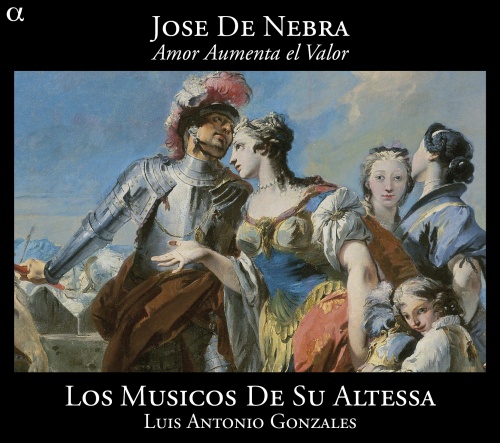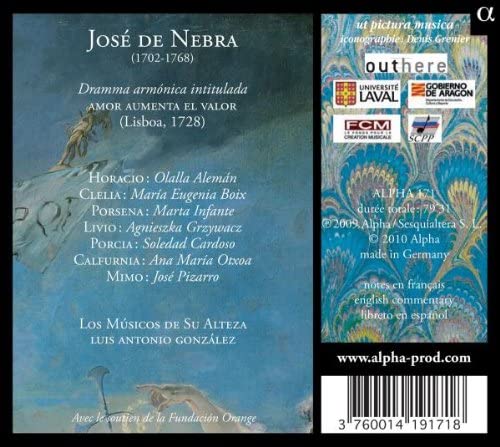
kompozytor
Nebra, Jose de
tytuł
NEBRA: Amor Aumenta el Valor, opera
wykonawcy
Los Músicos de Su Alteza;
González, Luis Antonio
González, Luis Antonio
nr katalogowy
Alpha 171
opis
Wykonawcy: Olalla Alemán (Horacio), María Eugenia Boix (Clelia), Marta Infante (Porsena), Agnieszka Grzywacz (Livio), Soledad Cardoso (Porcia), Ana María Otxoa (Calfurnia) & José Pizarro (Mim. On the one side, the Crown Prince of Asturias, Fernando of Bourbon (later Fernando VI of Spain) was betrothed to Princess Maria Bárbara de Braganza of Portugal; on the other, the Spanish Infanta María Ana Victoria was engaged to marry the Prince of Brazil, heir to the Portuguese throne. The opera in question, Amor aumenta el valor, composed by three talented musicians of the Spanish court – the Italians Giacomo Facco and Filippo Falconi, and the Spaniard José de Nebra – to a libretto by José de Cañizares - was part of a vast and costly celebration intended by tSpanish embassy to impress its guests by exceeding all expectations. Amor aumenta el valor was de Nebra’s first commission for the stage of the Spanish Court. It was also his last, for reasons unknown. We can however speculate that it may have been for the simple reason that Nebra was not Italian. Although Amor aumenta el valor was written as a Spanish opera, the librettist, de Cañizares, who was skilled in the art of writing zarzuelas in the style of Calderón, adapted perfectly to the pattern of Italian opera libretti. He used some traditional Spanish elements, but avoided seguidillas, romances and other poetic and musical forms. It is possible that Facco was responsible for the overall formal plan of the work. But musically the stylistic unity suffered somewhat, as may be seen if we compare the surviving pieces: Facco’s prologue and de Nebra’s first act. Indeed, the formal typologies are the same, but the music differs greatly. The plot is loosely based on Book II of Livy’s History of Rome or Ab urbe condita, relating the last moments of the monarchy and the ascension of the Roman Republic. Cañizares treats this story very freely, omitting some episodes, and adding new characters—Livius, Porcia, and the graciosos Mimo and Calfurnia. From 1669 to 1677, the Vicar General of Aragón, second Don Juan de Austria and son of Felipe IV and the actress María Calderón, maintained in the town of Zaragoza a prestigious chamber ensemble formed of highly regarded music ans of diverse origins. The ensemble, named Músicos de Su Alteza was founded by Luis Antonio González in 1992 with the aim of reviving the most significant works from that particular period in Spanish baroque. The group works closely with scholars and musicologists and have been responsible for the rediscovery of Joseph Ruiz Samaniego’s Villancicos, Vísperas and Lamentaciones as well as works by Juan Pérez Roldán, Filippo Coppola (his opera El robo de Proserpina and his Requiem) and José de Nebra.
nośnik
CD
gatunek
Muzyka klasyczna
producent
Alpha
data wydania
02-11-2010
EAN / kod kreskowy
3760014191718

(Produkt nie został jeszcze oceniony)
cena 79,00 zł
lubProdukt dostępny.
Wysyłka w ciągu 3 dni roboczych
Darmowa wysyłka dla zamówień powyżej 300 zł!
Darmowy kurier dla zamówień powyżej 500 zł!
sprawdź koszty wysyłki


























